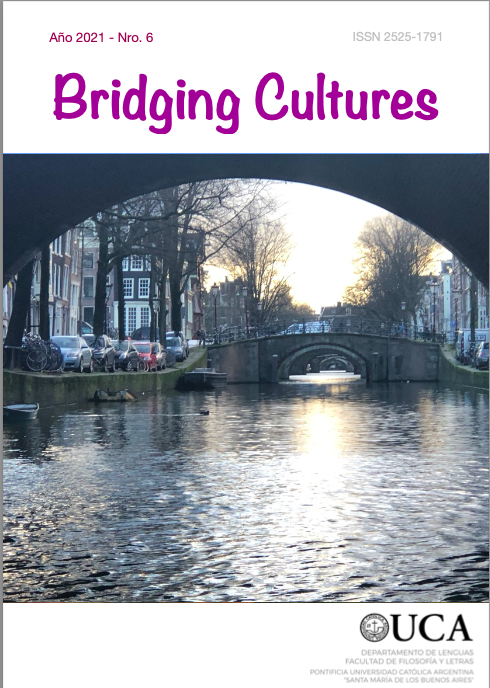Delving Into Multi-word Verbs: A Semantic and Syntactic Perspective
Keywords:
multi-word verbs, semantics, syntax, phrasal verbs, prepositional verbs, phrasal prepositional verbs, verb-adjective combinations, verb-nominal combinations, fixed expressionsAbstract
This paper focuses on a particular category of verbs known as multi-word verbs, verb combinations or group verbs, which category constitutes a key element of the English lexicon and is characterized by considerable dissensus among linguists. In order to shed some light on this topic, this work examines the concept of multi-word verbs, their main features, and the different subcategories they comprise, adopting a semantic and syntactic approach. For such end, it alludes to the most significant characteristics of each subcategory and provides examples thereof. Furthermore, it points out some of the problems that the lack of recognition of these verbs may pose for the understanding of texts.Downloads
References
Blake, N. F. (2002). Phrasal verbs and associated forms in Shakespeare. Atlantis, 24(2), 25-39. https://www.jstor.org/stable/41055068
BNC Consortium. (2007). British National Corpus, XML edition. Oxford Text Archive.
Celce-Murcia, M., & Larsen-Freeman, D. (1999). The grammar book: An ESL/EFL t’acher's course (2nd ed.). Heinle & Heinle.
Claridge, C. (2000). Multi-word verbs in early modern English: A corpus-based study. Rodopi.
Darwin C. M., & Gray L. S. (1999). Going after the Phrasal Verb: An alternative approach to classification. TESOL Quarterly 33(1), 65-83. https://doi.org/10.2307/3588191
Denison, D. (1981). Aspects of the history of English group-verbs. With particular attention to the syntax of the ormulum (Ph. D. Thesis, Oxford University, England).
Fraser, B. (1976). The verb-particle combination in English. New York: Academic.
Hiltunen, R. (1983). The decline of the prefixes and the beginnings of the English Phrasal Verb. (Annales Universitatis Turkuensis, Series B., Vol. 160). University of Turku, Finland.
Martinez, R. (2013). A framework for the inclusion of multi-word expressions in ELT. ELT Journal, 67(2), 184-198. https://doi.org/10.1093/elt/ccs100
Merriam-Webster. (n.d.). Break open. In Merriam-Webster.com Dictionary. Retrieved October 4, 2020, from: Merriam-Webster.com Dictionary.
Muñoz-Basols, J., & Salazar, D. (2016). Cross-linguistic lexical influence between English and Spanish. Spanish in Context 13(1) 80–102. https://doi.org/10.1075 /sic.13.1.04mun
Negro Alousque, I. (2011). A contrastive semantic analysis of English, Spanish and French idioms. Revista Canaria de Estudios Ingleses, 63, 113-123. https://riull.ull.es /xmlui/bitstream/handle/915/12551/RCEI_63_%28%202011%29_09.pdf?sequence=1&isAllowed=y
Oxford University Press. (n.d.). Blow out. In Lexico.com. Retrieved October 18. 2021https://www.lexico.com/definition/blow_out
Oxford University Press. (n.d.). Burn out. In Oxford L’arner's Dictionaries. Retrieved October 18, 2021, from: https://www.oxfordlearnersdictionaries.com/definition/english/burn-out
Quirk, R., Greenbaum S., Leech, G. & Svartvik J. (1985). A comprehensive grammar of the English language. Longman.
Solomon, A. R. (2013). What’s love got to do with it? A content analysis of English and Spanish idiomatic expressions. Honors Theses, 178. Retrieved October 4, 2020, from: https://aquila.usm.edu/cgi/viewcontent.cgiarticle=1110&context =honors_theses
Szabó, Z. G. (2020). Compositionality. In Edward N. Zalta (ed.) The Stanford Encyclopedia of Philosophy. Retrieved September 26, 2020, from: https://plato.stanford.edu/archives/fall2020/entries/compositionality
Thim, S. (2012). Phrasal verbs: The English verb-particle construction and its history. (Topics in English Linguistics 78). Mouton de Gruyter.
Downloads
Published
How to Cite
Issue
Section
License







 Bridging Cultures
Bridging Cultures